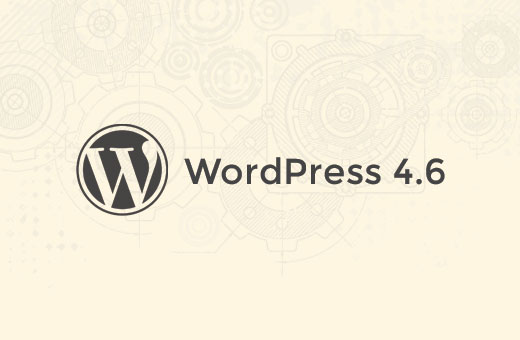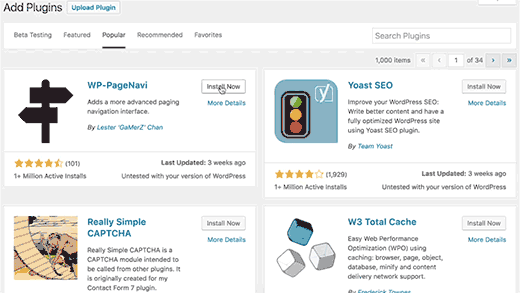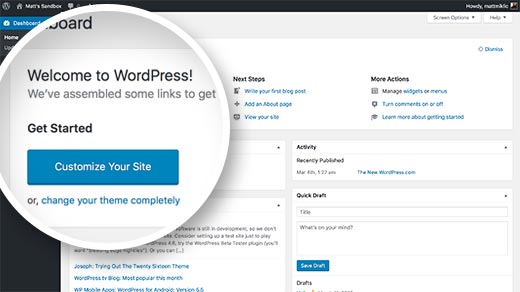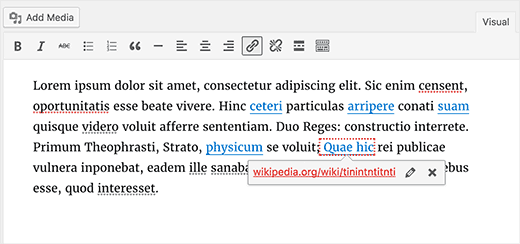Die Beta-Version von WordPress 4.6 wurde veröffentlicht. Wir haben die Entwicklung genau verfolgt und freuen uns zu berichten, dass die endgültige Version voraussichtlich um den 16. August 2016 veröffentlicht wird. In diesem Artikel werden wir die Neuerungen von WordPress 4.6 mit Funktionen und Screenshots vorstellen.

Hinweis: Sie können die Beta-Version auf Ihrem Computer oder in einer Staging-Umgebung ausprobieren, indem Sie das WordPress Beta Tester Plugin verwenden.
Dies ist die Beta-Version, was bedeutet, dass bis zur endgültigen Veröffentlichung von WordPress 4.6 keine weiteren neuen Funktionen hinzugefügt werden. Es kann jedoch sein, dass einige der Funktionen in der Beta-Version es nicht in die endgültige Version schaffen.
Glänzende Updates in WordPress 4.6
Wenn Benutzer ein neues Plugin oder Theme installierten oder aktualisierten, sahen sie normalerweise einen Fortschrittsbildschirm. Dieser Fortschrittsbildschirm lud eine weitere Seite und lenkte ein wenig ab.
Mit WordPress 4.6 werden glänzende Updates eingeführt. Nutzer können nun Plugins und Themes aktualisieren und installieren, ohne zum Fortschrittsbildschirm weitergeleitet zu werden.

Native System-Schriftarten im WordPress-Admin-Bereich
WordPress begann mit der Verwendung der Schriftart Open Sans im WordPress-Administrationsbereich, um ein einheitliches Erscheinungsbild auf verschiedenen Geräten und Plattformen zu gewährleisten. Dies bedeutete jedoch, dass WordPress auf eine externe Quelle von Drittanbietern angewiesen war. Dies verlängerte auch die Ladezeiten des Admin-Bereichs und beeinträchtigte die Geschwindigkeit.
Mit WordPress 4.6 wird der Verwaltungsbereich wieder die Systemschriftarten verwenden. Das bedeutet, dass Ihr WordPress-Administrationsbereich auf verschiedenen Plattformen etwas anders aussehen kann.
Hier ist ein Screenshot des Admin-Bereichs im Safari-Webbrowser auf macOS mit der Systemschriftart San Francisco.

Dies sind die Systemschriften, die im WordPress-Adminbereich auf verschiedenen Plattformen und Umgebungen verwendet werden.
- apple-system für Safari und Firefox unter macOS und iOS
- Helvetica Neue für macOS vor 10.11
- BlinkMacSystemFont für Google Chrome unter macOS
- Segoe UI für Windows
- Roboto für Android und Chrome OS
- Oxygen-Sans für KDE
- Ubuntu für Ubuntu
- Cantarell für GNOME
- sans-serif, die Standardausweichlösung
Hinweis: Diese Änderung betrifft nur die UI-Elemente des WordPress-Adminbereichs. Sie wirkt sich nicht auf Inhaltsbereiche wie den Post-Editor aus, der das Editor-Stylesheet Ihres Themes für Schriftarten verwendet.
Editor-Verbesserungen in 4.6
Die meisten WordPress-Benutzer verbringen mehr Zeit mit dem Post-Editor als mit jedem anderen Verwaltungsbildschirm auf ihrer Website. Die Verbesserung der Post-Editing-Erfahrung hat bei neuen WordPress-Versionen immer Priorität.
Verbesserte Funktion zum automatischen Speichern
WordPress 4.6 bringt Verbesserungen für die automatische Speicherfunktion in WordPress. Wenn Benutzer zuvor Revisionen deaktiviert hatten, wirkte sich dies auch auf die Wiederherstellung von Beiträgen aus der automatischen Speicherfunktion aus.
Mit WordPress 4.6 wird dieses Problem behoben und Benutzer können WordPress-Beiträge aus Browser-Backups und der automatischen Speicherung wiederherstellen, auch wenn sie Revisionen deaktiviert haben.
Hervorhebung fehlerhafter Links
Wenn Sie den visuellen Editor zum Schreiben von Beiträgen verwenden, wird das Hinzufügen einer fehlerhaften URL hervorgehoben.
Sobald Sie einen Link hinzufügen, prüft WordPress, ob der Link gültig ist. Wenn Sie mit dem Cursor auf den verlinkten Text gehen, wird der Link in roter Farbe statt in der üblichen blauen angezeigt.

Verbesserungen unter der Haube
Diese Updates verbessern wesentliche Teile des WordPress-Kerns, sind aber hauptsächlich für Entwickler gedacht.
Standardisierte Registrierung von Metadaten
WordPress 4.6 bringt die Funktion register_meta() für die Registrierung von Metaschlüsseln. Diese Funktion funktioniert wie die Funktion register_post_type(). Sie ermöglicht es Plugins und Theme-Entwicklern, einen standardisierten Weg zu nutzen, um mit Metadaten zu arbeiten, die in den Objekttypen Posts, User, Comment oder Terms gespeichert sind.(#35658)
Neue Klasse WP_Post_Type
WordPress 4.6 wird die neue Klasse WP_Post_Type einführen. Sie ändert $wp_post_types in ein Array von WP_Post_Type-Objekten. Dies bietet Methoden zur Handhabung von Post Type Supports, Rewrite Rules, Meta Boxen, Hooks und Taxonomien.(#36217)
Neue Klasse WP_Term_Query
Ähnlich wie die Klassen WP_Query, WP_User_Query und WP_Comment_Query wird WP_Term_Query in WordPress 4.6 eine bessere Struktur für die Erstellung von Term-Abfragen bieten.(#35381)
WP_Site_Query und WP_Network_Query Klassen
Für WordPress-Multisite-Netzwerke ermöglichen die neuen Klassen WP_Site_Query und WP_Network_Query die Abfrage von Sites und Netzwerken mit Lazy Loading.(#35791, #32504)
Wir hoffen, dass dieser Artikel Ihnen geholfen hat zu erfahren, was in WordPress 4.6 kommen wird. Lassen Sie uns wissen, welche Funktionen Sie spannend finden und was Sie sich für zukünftige Versionen von WordPress wünschen.
Wenn Ihnen dieser Artikel gefallen hat, dann abonnieren Sie bitte unseren YouTube-Kanal für WordPress-Videotutorials. Sie können uns auch auf Twitter und Facebook finden.





Nico
WordPress should have a tool like GoogleDev Tools (Source Render) to code Front-End without so many plugins involve and all the nightmare.
PLS Freedom to front-end developers!
Why do I have to use an editor like the Family Game or Sega?
I mean WordPress should add kind of a GoogleDev Tools to work and update HTML, CSS and JS.
And keep the plugins for those who don’t want to code. But at least think in Developers if you have a Woocommerce environment, and so many stuff to work bigger, think bigger WordPress.
If you have Woocommerce, stop the blog plugin-based software style and make a complete front-end developer side.
Besides, I’m not interested in programming back-end PHP functions. WordPress is a great back-end solution.
Or do I write this for nothing and is there already a tool for what I’m saying and I’ve been going crazy with this nightmare plugin’s land?
Pls anyone can help???
Best regards
kris
I would love to have wordpress remember the category of the last post, when creating a new one,, it would be already selected… rather than the default ‘about’
huge time saver imho
WPBeginner Support
WordPress uses the default category as the pre-assigned category for new posts.
Admin
kris
thanks! right you are. after 6 years of using wordpress. I learn something so basic
although my suggestion is still valid,
Grant Winney
It’s great to see improvements still being made, and that someone’s paying attention to response time.
The link validator strikes me as odd. Nearly every single time I’ve pasted a link into a post, I’ve just copied it from another tab where I have the page open. I can’t remember a time I had a link sitting around in a text file or something, and the site had died between when I copied the link and referenced it in a post.
Sandeep Mohanty
Thanks for the list of WordPress 4.6 Very Good.
Brian
Still waiting for Plug-in search filters. Filter by currently available fields for compatibility, active installs, and last update would be a huge improvement.
Osman
Yeah plugin search filters will be added !!!
Manjunath Naik
Thanks for useful information.
Dan Heath
Keep wishing for pages to show specified categories of post, and only those categories. I create a page about constructing a canopy. I only want posts for the categories I specify, such as “Canopy”, to show up on that page. If I do not specify any categories for that page, then it shows all posts.
The stuff in this release is OK, but not really relevant to my needs. What I asked for here, I have asked for many times. If I could write a plug in for it I would. If anyone knows of a plug in that will do this, I sure would like to know.
Shaun Nestor
Hi Dan,
To have a page only show posts in a certain category is quite simple, just point your users to the /category/ URL
For example, if your website is at http://www.example.com and your canopy posts are all in the category ‘Canopy’, you can send users to http://www.example.com/category/canopy/
I hope this addresses the frustration you’ve been experiencing.
-Shaun
Dylan MacDonald
This no longer works for me in WordPress 4.6. All of my category pages are now blank . Is this a known issue?
Sufyan Shaikh
thank you so much on giving idea of what will be there in WordPress 4.6.
Arta
The editor link checker is amazing.
Triet Minh
Interesting update! it’s worth the wait.
ibrar
nice information bro good thing about wordpress
Loi Tran
Thanks for the informative and well put together post.
Temitayo Boboye
Wow!!! this is so great, I love the Plugin Update and the WP_Post_Type. Can’t wait to see these in action. Going for Beta now #GoingForBeta
John Brian Shannon
“When users installed a new plugin or theme, or updated one, they usually saw a progress screen. This progress screen added one more page load and was a bit distracting.”
Congratulations to WordPress! This is a major irritant to many people, especially if traveling through an area with slow internet.
And all of those progress page loads combined — from all sources 24/7 all across the internet — act to slow down the entire net, by adding millions of such operations per day. It’s outrageously wasteful and time consuming in it’s internet totality.
I hope that soon, not only website hosts such as WordPress, but all sites on the web follow the leadership of WP on this.
Thanks for posting this article. Well done.
Cheers, JBS
Kosta
Hm, Nothing Special At This Patch
Emily
If you have any influence, a very nice and very basic upgrade would be to have an “Are you sure?” dialog box after you press the Publish button. It is astonishing that this hasn’t been part of WordPress since the very first version.
Lin
Emily – there’s a plugin that I found just recently after hitting Publish instead of Saved Draft. The one I found and am using is called “Publish Confirm.” Lifesaver! And, yes, it should be in the basic WordPress.
Davide De Maestri
Thank you for this quick list of WordPress 4.6 news!